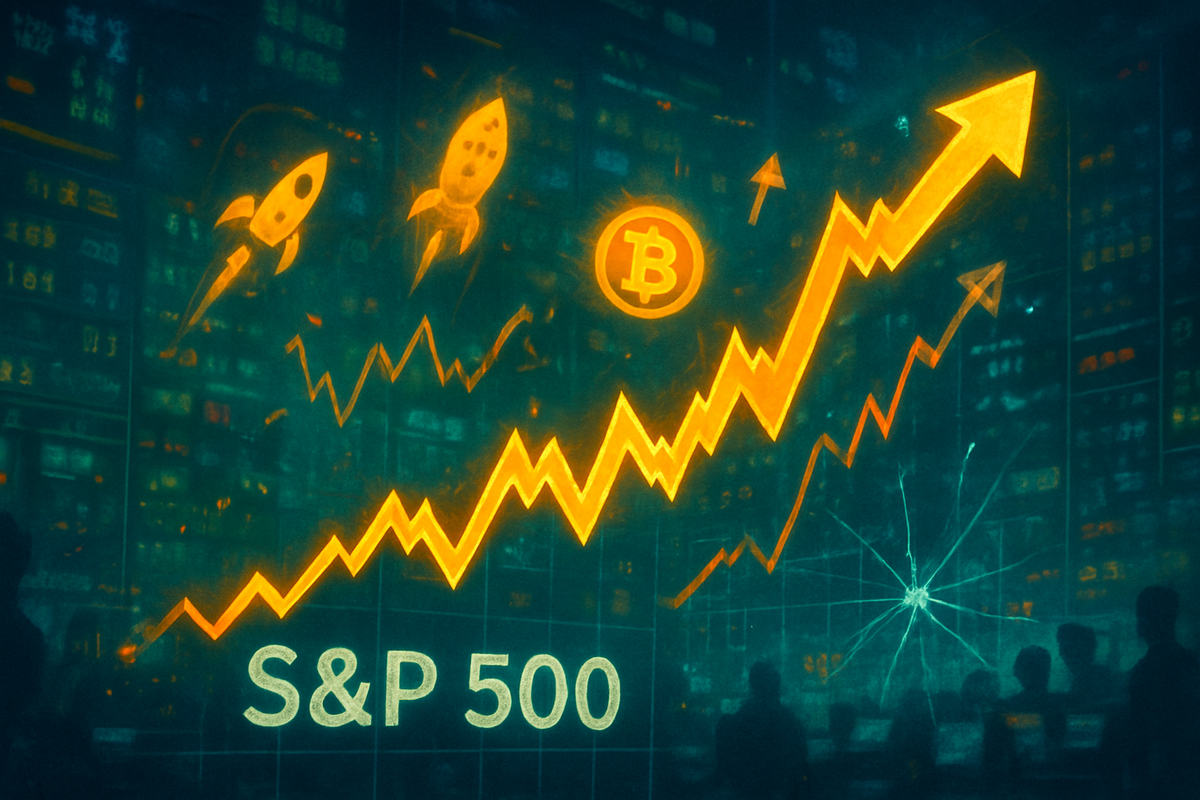
The S&P 500, long considered the benchmark of blue-chip American corporate strength, has in recent months taken a notable turn towards embracing companies with characteristics once deemed more speculative. As of late 2025, a palpable market exuberance, fueled by a roaring AI boom and a resurgence of retail-driven speculative trading, appears to be influencing the composition of the venerable index. This shift raises questions about the index's traditional role as a bastion of stability and signals a potential redefinition of what constitutes a "mainstream" investment in an increasingly frothy market.
This trend is not merely anecdotal; it's reflected in the inclusion of several companies known for their higher volatility or association with past speculative frenzies. While the S&P Dow Jones Indices committee maintains rigorous criteria for inclusion, the very nature of the market has evolved, pushing previously niche or high-growth sectors into the financial mainstream. The current environment, marked by record highs and a "fear of missing out" (FOMO) among investors, suggests that the index is adapting to, and perhaps even legitimizing, the market's increasingly adventurous appetite.
The Shifting Sands of Index Inclusion
The S&P 500's inclusion criteria are stringent, requiring a U.S.-based company listed on a major exchange, with a substantial market capitalization (raised to $22.7 billion as of July 1, 2025), high liquidity, and consistent positive GAAP earnings. However, recent adjustments and the prevailing market sentiment have created an environment where companies with a history of significant price swings and strong retail investor interest are finding their way in. The lowering of the float-adjusted liquidity ratio (FALR) requirement to 0.75, effective January 4, 2023, for instance, reflects increased market liquidity and potentially eases the path for some more actively traded, albeit volatile, stocks.
The year 2025 has been characterized by a "speculative surge." This period has seen a notable resurgence of "meme stocks" and record-high options trading, particularly in risky zero-day-to-expiration (0DTE) options. Retail investors, brimming with optimism, have poured capital into a select group of high-growth companies, especially those perceived to be at the forefront of the artificial intelligence revolution. This enthusiasm, coupled with substantial cash reserves awaiting potential interest rate declines, has intensified speculative activity. Against this backdrop, several companies fitting the description of "dicey" or highly volatile have either been added to the S&P 500 or have seen their profiles elevated within the index.
Among the notable additions, Robinhood Markets (NASDAQ: HOOD) joined the S&P 500 on September 22, 2025. Robinhood, once synonymous with the "meme stock" phenomenon due to its no-commission trading app, represents a clear example of a company with a strong retail following and a history tied to speculative trading. Other high-profile inclusions reflecting this trend include Palantir Technologies (NYSE: PLTR), added in September 2024, known for its AI focus and retail investor popularity, and Super Micro Computer (NASDAQ: SMCI), which topped the list of most volatile S&P 500 names in 2024 due to its AI-driven surge and subsequent volatility. DoorDash (NASDAQ: DASH), TKO Group Holdings (NYSE: TKO), Williams-Sonoma (NYSE: WSM), and Expand Energy (NYSE: EXE) were added in March 2025, with DoorDash immediately jumping on the news. More recently, AppLovin (NASDAQ: APP) and Emcor Group (NYSE: EME) joined in September 2025, and Interactive Brokers Group (NASDAQ: IBKR) in August 2025. These additions underscore the index committee's willingness to incorporate companies that reflect the current market zeitgeist, even if they carry a higher perception of speculative appeal.
Winners, Losers, and Market Implications
The inclusion of these more volatile or growth-oriented companies within the S&P 500 creates clear winners and poses significant questions for the broader market. The immediate beneficiaries are the newly added companies themselves. Inclusion in the S&P 500 triggers automatic buying by passive index funds and exchange-traded funds (ETFs) that track the index, providing a substantial, sustained boost to their stock prices and liquidity. Companies like Robinhood (NASDAQ: HOOD), AppLovin (NASDAQ: APP), and DoorDash (NASDAQ: DASH) can expect increased institutional ownership and a degree of legitimacy that can attract further investment. For firms like Palantir (NYSE: PLTR) and Super Micro Computer (NASDAQ: SMCI), already riding the AI wave, index inclusion further solidifies their position and amplifies their market presence.
However, the implications are not uniformly positive. For investors, particularly those in passive index funds, the increased presence of "dicey stocks" means a greater exposure to volatility. While these companies offer higher growth potential, they also come with higher risk profiles, potentially leading to larger swings in portfolio values. The market as a whole could become more susceptible to rapid shifts in sentiment, reminiscent of past speculative bubbles. Companies that meet the S&P 500 criteria but are still perceived as too speculative, such as Coinbase Global (NASDAQ: COIN) which did not make the cut in March 2025, or other meme stocks like Kohl's (NYSE: KSS), Opendoor (NASDAQ: OPEN), and Beyond Meat (NASDAQ: BYND), might find it harder to sustain their speculative rallies if they lack the legitimizing force of index inclusion. This could create a two-tiered market where index constituents, regardless of their inherent volatility, are somewhat insulated by passive flows, while others remain exposed to the whims of retail sentiment.
Wider Significance and Historical Echoes
This evolving composition of the S&P 500 signifies a broader industry trend where traditional benchmarks are adapting to a rapidly changing market landscape. The lines between established blue-chips and high-growth, often volatile, disruptors are blurring. The index, once a symbol of stability, is increasingly reflecting the prevailing market exuberance, potentially mainstreaming what were once considered niche or speculative plays. This could have ripple effects, encouraging other indices to follow suit or prompting a reevaluation of investment strategies that rely heavily on passive index tracking.
The potential for increased volatility across the entire index is a significant concern. If a substantial portion of the S&P 500's market capitalization is tied to companies with less predictable earnings or higher sensitivity to market sentiment, the entire benchmark could become more prone to sharp corrections. Regulatory bodies may also begin to scrutinize this trend more closely, particularly if it leads to heightened market instability or exposes retail investors to undue risk through passive investment vehicles. Historically, periods of intense market exuberance, often accompanied by the inclusion of high-flying, speculative stocks in major indices, have frequently preceded significant market corrections, such as the dot-com bubble of the late 1990s. While current economic fundamentals differ, the rapid ascent of certain sectors, the concentration of gains in a few large companies, and the elevated price-to-earnings (P/E) ratios of the S&P 500 approaching pre-2000 levels serve as cautionary historical precedents.
What Comes Next?
In the short term, the market is likely to continue its dance with exuberance. The "dicey stocks" that have recently joined the S&P 500 will likely continue to experience heightened volatility, driven by both fundamental performance and speculative trading. Further additions of high-growth, high-beta companies to the index are possible if the current market sentiment persists. Investors should brace for potential strategic pivots, as fund managers and individual investors reassess their exposure to index-tracking products and consider more active management to navigate the increased risk. Market opportunities may emerge for those adept at identifying fundamentally sound companies within the volatile growth sector, while challenges will arise for those who fail to differentiate between genuine innovation and pure speculation.
Looking further ahead, the long-term implications are less clear. Will these newly added companies mature into stable, consistent performers, or will some prove to be temporary fads, eventually removed from the index? The trajectory of interest rates, the sustainability of the AI boom, and the broader economic climate will all play crucial roles in determining whether the current exuberance leads to a soft landing or a more significant market correction. Scenarios range from a continued, albeit more moderated, growth phase for these companies, to a sharp reversal if market sentiment sours, potentially leading to a broader market downturn exacerbated by the S&P 500's increased exposure to speculative assets.
A New Era for the Benchmark
The S&P 500's recent embrace of "dicey stocks" marks a significant moment for the financial markets. It underscores a fundamental shift in what constitutes a benchmark company, reflecting the current era of market exuberance, technological disruption, and heightened retail investor influence. The key takeaway is that the S&P 500, while still a critical barometer of U.S. corporate health, is now a more dynamic and, arguably, more volatile entity.
Moving forward, investors must acknowledge that passive investment in the S&P 500 now carries a different risk profile than it might have a decade ago. While the index still offers diversification, its increasing exposure to companies with higher growth expectations and greater price sensitivity means a potentially bumpier ride. The lasting impact of this trend will depend on how these new constituents perform over time and whether the broader market can sustain its current valuations. Investors should closely watch corporate earnings reports from these newly included companies, any shifts in the S&P Dow Jones Indices committee's criteria, and, critically, the Federal Reserve's stance on interest rates, which could significantly impact speculative appetite. The S&P 500 is evolving, and with it, so too must investor expectations and strategies.
This content is intended for informational purposes only and is not financial advice





